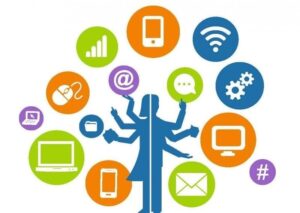In today’s society, new generations are required to have an advanced level of digital competence, as they are in continuous transformation, the learning habits of students have changed, their needs and circumstances are no longer the same as ten years ago, which is why it is essential that schools can learn how to provide an educational, didactic and safe response to the needs of students. To achieve this, it requires a teacher with an updated training and possessing a degree of digital competence to undertake the teaching-learning process of students and to promote the acquisition of key competencies in students.
This, we define teaching digital competence as a set of skills, competencies, knowledge and attitudes that teachers must have in order to make a critical, dynamic and creative use of ICT in their classrooms.
Why is continuous teacher training important?
The importance of teacher training at the digital educational level, both initial and continuous, is essential for the success of the educational system. Innovation and research are part of the teacher’s role to promote the continuous improvement of teaching processes in the different educational stages.
Useful teacher training should bring together different skills such as promoting confidence, self-esteem, creativity, innovation capacity, educational problem solving and the ability to incorporate new resources into the classroom.
Teacher training should consist of two phases:
- Initial training: deals with familiarizing the teacher in the recognition and basic handling of the different technological devices that will be in the classrooms, exploring their main tools and the identification of digital educational materials.
- Ongoing training: the teacher has a variety of training proposals that will lead him/her to reflect on the use of ICT in education and to creatively use the resources developed for primary and secondary school subjects.
What are the objectives of lifelong learning?
- Acquisition of knowledge, concepts or facts to be acquired.
- Acquisition of attitudes, behaviors to be generated and developed
- Development of skills to be mastered
What are the five pillars of digital competence in teaching?
Competency training is based on the union of two theoretical concepts from the educational sciences: cognitivism and constructivism. On the one hand, cognitivism is concerned with the way in which the learner acquires and applies knowledge and skills; on the other hand, constructivism emphasizes the active role of the learner.
In the following section, you will find the five competencies that a teacher should take into account in his or her personal and professional training:
- Computerization and information literacy. The teacher should know how to identify, organize, retrieve, store, and analyze information and digital content, evaluating its purpose.
- Communication and elaboration. This competence means that the teacher has to master communication in the digital environment, share resources and tools, share, interact and participate in communities and networks

- Creation of digital content. In this competence, the teacher must know how to create and edit new content, link and rework previous knowledge and content, make artistic productions, multimedia content and computer programming.
- Security. It is the essential and key digital skill and consists of personal protection, data protection, digital identity protection, use of security.
- Problem solving. This competence is focused on knowing how to identify needs and digital resources and also in making decisions when choosing digital resources.

How to improve teachers’ digital skills?
- Have a positive attitude towards ICT.
- To know the uses of ICT in the educational field.
- Know the use of ICT in the field of their area of knowledge.
- Skillfully use ICT in their activities: text editor, e-mail and Internet browsing.
- Acquire the habit of planning the curriculum integrating ICT.
- Propose training activities to students that consider the use of ICT.
- Permanently evaluate the use of ICT.
Use of technology in the classroom
Currently, teachers have many advantages when working in their classrooms, since there is a wide variety of digital tools that help the teacher to teach classes and evaluate students in an agile and effective way.
Among the most didactic, professional tools that serve as a great help to the teacher when preparing their classes: Additio which has a series of functions to facilitate many of the tasks that a teacher performs when preparing and teaching their classes such as:
- Gradebook: allows the management of groups of students and their notes in a practical and simple way.
- Lesson planner: another of Additio’s functions to facilitate the teacher’s tasks is the lesson planner.
- Calendar and schedules: with the platform you can create calendars with scheduled events, which can be displayed with a weekly or monthly view.
- Data import and export: Additio has a data import system from files created in Microsoft Excel spreadsheet.
- Sharing with other teachers, families and students: the system of notes, calendars, events and other data can be shared with other teachers using the application.


